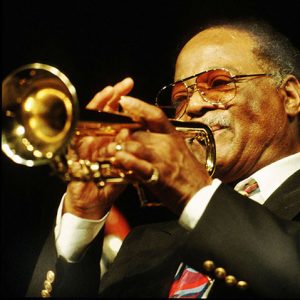calsfoundation@cals.org
Clark Terry (1920–2015)
Trumpeter and flugelhornist Clark Terry inspired audiences in a jazz career that spanned more than seventy years and included work with some of the biggest names in American music. Terry was one of the most recorded musicians in the history of jazz and performed for eight U.S. presidents and served as a jazz ambassador for State Department tours in the Middle East and Africa. Terry moved to Pine Bluff (Jefferson County) in 2006 and was active in musical activities associated with the University of Arkansas at Pine Bluff (UAPB), along with mentoring music students from around the world. He died in 2015 at the age of ninety-four.
Clark Terry Jr. was born on December 14, 1920, to Clark Terry Sr. and Mary Terry in St. Louis, Missouri. He was the seventh of eleven children. Terry’s inspiration for music came when his older sister married a tuba player, Sy McField, who played for a popular area band, Dewey Jackson and the Musical Ambassadors. During this time, Terry started developing an interest in music but did not have the money to purchase an instrument. Consequently, he and his brother took a piece of garden hose and other assorted parts and made instruments to play. The neighbors got so tired of hearing the two playing their new contraptions that several pitched in and bought them a trumpet for $12.50 at a pawn shop.
By the time Terry graduated from Vashon High School, he was playing in clubs in St. Louis. He then enlisted in the U.S. Navy in 1942, where he played with the U.S. Naval Band while stationed in Chicago, Illinois. After his military service, Terry began to play with professionals in Chicago such as Charlie Barnet, Lionel Hampton, and George Hudson. In 1948, he joined Count Basie’s band. He played with Basie until Duke Ellington approached him about switching bands. Ellington proved to be an enormous influence on Terry, both musically and with regard to the business of entertainment.
Terry went on to play with the Quincy Jones orchestra in 1959. The next year, he accepted an invitation to be part of the Tonight Show band, where he became the first African-American staff musician employed by the National Broadcasting Company (NBC). He held this position for twelve years until the show moved to Los Angeles, California. Meanwhile, he remained in New York to form his own band and focus on his recording career.
Terry made more than 900 recordings, making him one of the most recorded jazz artists in history. He received the Grammy Lifetime Achievement Award (2010), two Grammy certificates, and was nominated for a Grammy Award three times. In addition, he received many honorary doctorates.
Terry and his wife, Gwen, moved to Pine Bluff in 2006 in order to be closer to his children in Dallas, Texas. He took part in two Clark Terry Jazz Festivals in cooperation with UAPB. He taught as an adjunct professor at UAPB and mentored UAPB music students as well as other students from around the world who came to the area to study with him. In 2014, the documentary Keep on Keepin’ On—filmed, in part, in Pine Bluff— was released; it followed Terry’s mentorship of a blind Australian teen musician.
Terry died on February 21, 2015. Terry was inducted into the Arkansas Jazz Hall of Fame in 2016.
For additional information:
Clark Terry. http://clarkterry.com/ (accessed September 23, 2021).
“Clark Terry.” Jazz Foundation of America. http://jazzfoundation.org/real-stories/clark-terry (accessed September 23, 2021).
“Clark Terry.” National Visionary Leadership Project. http://www.visionaryproject.org/terryclark/ (accessed September 23, 2021).
Keepnews, Peter. “Clark Terry, Influential Jazz Trumpeter, Dies at 94.” New York Times, February 22, 2015. http://www.nytimes.com/2015/02/23/arts/music/clark-terry-influential-jazz-trumpeter-dies-at-94.html (accessed September 23, 2021)
Terry, Clark, with Gwen Terry. Clark: The Autobiography of Clark Terry. Berkeley: University of California Press, 2011.
Jimmy Cunningham
Nashville, Arkansas
 Divergent Prosperity and the Arc of Reform, 1968–2022
Divergent Prosperity and the Arc of Reform, 1968–2022 Clark Terry
Clark Terry 




Comments
No comments on this entry yet.